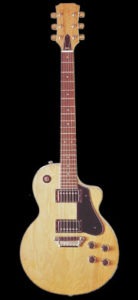Musicians, as a group, are quite conservative when it comes to their equipment. They tend to want to play the same guitars and basses, and use the same amplifiers, as the players who influenced them. Thus, any company trying to break into that market has an uphill battle. Such has been the case with Yamaha and electric guitars.
Since they started crafting acoustic guitars in the ’40s, Yamaha had a leg up in that category. Nylon string, steel string, flamenco, classical — by the ’70s Yamaha had begun to be recognized as a serious acoustic guitar brand, chosen by Paco De Lucia, Liona Boyd, and other world-class players. Even Andres Segovia was an admirer.
In the pop world, Yamaha gained notoriety as well, with artists as diverse as James Taylor, Paul Simon, Bob Seeger, John Denver, and Jimmy Page (Led Zeppelin). They continue to be popular to this day, played by Dave Navarro(Jane’s Addiction, Red Hot Chili Peppers), Liz Phair, Suzanne Vega, and countless others.![]()
 Going Electric
Going Electric
But not until the mid ’60s did Yamaha even begin manufacturing electric guitars. Initially, they enjoyed some success with funky instruments that appealed to “surf” bands, but that faded with the explosion of arena rock in the late ’60s and early ’70s. In 1972, the Yamaha SG40 and SG45 were introduced.
Taking their cue from the long-term popularity of Gibson Les Paul guitars, these models featured symmetrical, 3-pegs-to-a-side headstocks, two humbucking pickups, and thick, single-cutaway solid bodies. But though their reputation for quality was universally accepted, Yamaha still did not gain a serious entrance into the world of electric guitar sales.
Artists Drive the Desire
The problem? As stated previously, musicians tend to be conservative, as well as very derivative. When young, they idolize certain players. Naturally, they want to imitate the sound of those players. And, one of the most obvious ways to go about that is to employ the same equipment used by the musicians who influenced them.
NOTE: While equipment does play a large role in a guitar player’s sound, it is by no means the only factor. Playing techniques — not only the physicality of how the instrument is played, but the note and phrasing choices of the players — account for at least as much of the final outcome. As an example, see this article: Sounding Like Carlos Santana, as well as the followups, Playing Like Carlos Santana, and Carlos Santana’s Guitar Tone.
Back in the early ’70s, there was no big-name artist to serve as the spokesman for Yamaha electric guitars, and the Yamaha SG models remained in the background of the musical fabric. That all changed with the introduction of the Yamaha SG175, and the company’s relationship with a well-known Latin guitar player named Carlos Santana.

